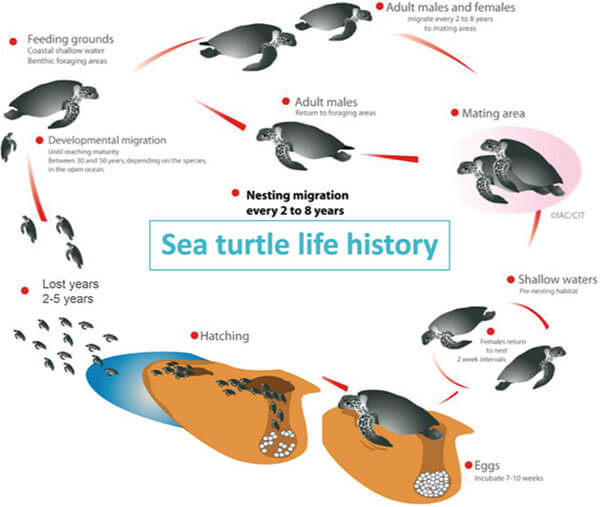
Life History Characteristics of Marine Turtles: What Are They and Why Are Adults and Juveniles So Different?
Mike Salmon, Ph.D., Research Professor
Florida Atlantic University .
Florida Atlantic University .
There is no question that the way living creatures go about the business of reproduction is complicated, so much so that there seems to be no end to how the process is described. Biologists, in an attempt to make some order out of this apparent chaos, have tried over the years to come up with overarching “principles”. These are largely based upon what qualities are characteristic of the two main actors, specifically, males and females.
Darwin, as so often is the case, was the first to do so with competence. His distinctions were based upon behavior. He characterized males as the sex most likely to spend time competing with other males for access to females, using aggression or conspicuous displays both to inhibit other males and to attract as many females as possible for mating. A consequence of those habits, incidentally, was the increased likelihood of risk-taking*. Unfortunately, aggression and other forms of competition often led to injuries and attracted predators, so males invariably suffered an earlier death than females. But for males, success was measured by the number of accomplished matings, not by how long they lived! Females, in contrast, were often drab in color, favored being inconspicuous, chose their mates carefully, stayed safe as long as possible, and used their time to convert food to as many surviving offspring as possible. Thus, as Darwin suggested, each sex had the same goal (maximizing offspring production) but went about the process behaviorally in entirely different ways.
An alternative perspective was developed by ecologists who while interested in behavioral differences between the sexes, were far more concerned with relationships between reproduction, on the one hand, and on the other hand by adaptations shown by populations to favor survival in their environment. They came up with a scheme based upon what they called “life-history characteristics”. According to this idea, “environments” can be characterized as either relatively stable (that is, changing slowly over long time periods) or unstable (subject to frequently unpredictable, sudden and drastic change caused by fire, storms, drought, flooding, etc.).
Organisms living in those contrasting environments exhibited very different reproductive strategies. In stable environments, organisms tend to be large, slow growing, live a long time, exist in populations that show little fluctuation in numbers, and produce only a few offspring over a long reproductive life span. Those youngsters receive lavish parental care and usually survive. In contrast, organisms living in unstable environments showed the antithesis of these characteristics. They tend to be small in size, grow quickly to sexual maturity, and produce many offspring in just one or a few reproductive episodes. Most of their offspring fail to survive. That’s because when conditions suddenly change, both adults and juveniles have to migrate elsewhere in search of another habitat. More often than not, they starve to death or are taken by predators before they can find a new home. But because so many offspring are produced, a few lucky ones usually find a new home so the cycle is repeated once again. Obviously, populations of these animals, again compared to species in stable habitats, fluctuate wildly over time. Those numbers are best described by the phrase “boom or bust”!
Ecologists soon recognized that most species didn’t fall neatly into one or the other category; instead, they exist along a continuum reflecting the extent to which their environment varied in its stability. Perhaps most interesting of all, some creatures, especially those found in marine habitats, show combinations of these life history characteristics, even within a species. Marine turtles are an excellent example (Figure 1).
powerful animals capable of effectively searching for, and finding, habitats favorable for feeding and resting. When they do, they stay there, often for years at a time. They depart only when the time comes to breed. For females, that’s after several years of feeding to accumulate enough energy for egg production, and to migrate hundreds of miles to nest at natal beach sites. For males, it’s usually an annual migration to intercept, court and mate with as many females as possible. But breeding takes only a few weeks and then both sexes use their superb navigational skills to return to their traditional foraging areas.
But the environments occupied by the eggs, hatchlings and juvenile marine turtles are, from their perspective, best characterized as unstable. Female marine turtles can’t defend nests and so after depositing their eggs in the sand, they hide the nest location as best they can and leave. Abandoned nests are subject to calamities that can occur suddenly, and at any time. The eggs (if found) are consumed by predators, washed out by storms, or invaded by ants and plant roots. If the beach sands get too cold, the eggs won’t develop; if too hot, the embryos will die; too wet, and the eggs will suffocate. The hatchlings that emerge from nests lucky enough to survive an unprotected 45- 60 day incubation period, must immediately complete a dangerous migration offshore to nursery areas hundreds of miles distant. Reef fish predators await them in the shallows and sea birds as well as pelagic fishes (tunas, dolphin, snappers and sharks) hunt for them in the open ocean. Small turtles have few defenses other than to hide but they must find food to grow. Searching for food exposes them to danger and so most of them are taken by predators or die from starvation, if or when their food supply vanishes. As they grow, the turtles gradually become less vulnerable to predators but even then, danger is never far away. Growing juveniles occupy different “developmental habitats” as they increase in size, or as the seasons change. They have to locate those habitats, a search that requires migration in open water (Figure 1). Those journeys always increase exposure to predators.
To compensate for these losses, female marine turtles produce hundreds of eggs during each breeding season, apportioned within several nests at different local beaches where there’s a good chance that at least a few nests will survive long enough to produce hatchlings. (Females obviously avoid putting all their eggs in one basket!) But producing that many eggs requires an ability to store lots of energy, and that can only happen if the turtles become large enough to accumulate huge reserves of fat. That’s why marine turtles are so much larger than most other turtles, and why they produce many more eggs than most turtle species living on land. Marine turtle nests can contain anywhere between 50 and 200 eggs, with the number depending upon both egg size and species. The bottom line: we’re left with a large, long-lived animal occupying a stable habitat that breeds just like small, short-lived creature occupying an unstable habitat. Why?
Adult marine turtles are extremely large, slow growing, take years to reach maturity and once they do live a long time. We know from historical observations made as little as 500 years ago that before humans began over exploiting them, populations of marine turtles were stable at numbers many times greater than exist today. Clearly, these are attributes of species that occupy stable environments and adult marine turtles do exactly that! They are big,

To repeat, it’s because marine turtles during their lifetime occupy two environmental extremes, just like the ones described earlier by ecologists - stable habitats as adults and unstable habitats as eggs, hatchlings and juveniles - and so they uniquely combine the life history characteristics we described above for different species into those for one species. Doing so is just another feature of their biology that makes these animals so unique, so interesting to study, and so remarkably different in both their ecology and behavior as they transition over the years from hatchlings and juveniles, leading dangerous and stressful lives, to adults who if they survive long enough to achieve that status, may finally get some relief. It’s also why those of us who study marine turtles have come to realize that what we learn about one life history stage doesn’t necessarily apply to other life history stages. In essence, we are faced with understanding the behavioral and ecological characteristics of two kinds of animals, both of which belong to the same species!
Helping Sea Turtles Survive for 39 Years
A NON-PROFIT ORGANIZATION
State of Florida Registration Number CH-2841 | Internal Revenue Code 501 (c) (3)
Web Design & Development by Web Expressions, LLC

